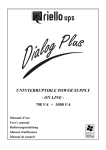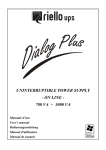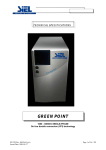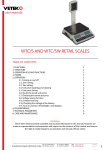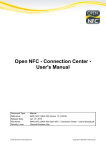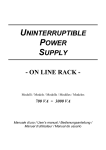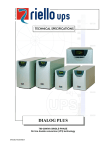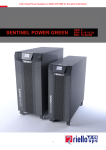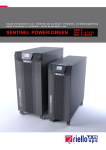Download Riello Dialog Plus DLP series User`s manual
Transcript
UNINTERRUPTIBLE POWER SUPPLY - ON LINE 700 VA ÷ 3000 VA User’s manual GB SAFETY GB This part of the manual contains precautions that must absolutely be followed as they relate to SAFETY. Installation ¾ Connect the UPS system only to an earthed shockproof socket outlet. ¾ The building wiring socket outlet (shockproof socket outlet) must be easily accessible and close to the UPS system. ¾ Please use only VDE-tested, CE-marked mains cable (e.g. the mains cable of your computer) to connect the UPS system to the building wiring socket outlet (shockproof socket outlet). ¾ Please use only VDE-tested, CE-marked power cables to connect the loads to the UPS system. ¾ When installing the equipment, it should ensure that the sum of the leakage current of the UPS and the connected consumer does not exceed 3.5mA. Operation ¾ This UPS is operated by laymen. ¾ Do not disconnect the mains cable on the UPS system or the building wiring socket outlet (shockproof socket outlet) during operations since this would cancel the protective earthing of the UPS system and of all connected loads. ¾ The UPS system features its own, internal current source (batteries). The UPS output sockets may be electrically live even if the UPS system is not connected to the building wiring socket outlet. ¾ In order to fully disconnect the UPS system, first press the OFF-switch then disconnect the mains. Maintenance, servicing and faults ¾ The UPS system operates with hazardous voltages. Repairs may be carried out only by qualified maintenance personnel. ¾ Caution - risk of electric shock. Even after the unit is disconnected from the mains power supply (building wiring socket outlet), components inside the UPS system are still connected to the battery and are still electrically live and dangerous. Before carrying out any kind of servicing and/or maintenance, disconnect the batteries and verify that no current is present. ¾ Only persons adequately familiar with batteries and with the required precautionary measures may exchange batteries and supervise operations. Unauthorised persons must be kept well away from the batteries. ¾ Caution -Batteries may cause electric shock and have a high short-circuit current. Please take the precautionary measures specified below and any other measures necessary when working with batteries: - remove wristwatches, rings and other metal objects - use only tools with insulated grips and handles. ¾ When changing batteries, install the same number and same type of batteries. ¾ Do not dispose of batteries in a fire. The batteries may explode. ¾ Do not open or mutilate batteries. Released electrolyte is harmful to the skin and eyes. It may be toxic. ¾ Do not dismantle the UPS system. 3 4 GB USER’S MANUAL GB 5 INTRODUCTION Thanks you for choosing our product. Our manufacturer are renowned specialists in the development and production of uninterruptible power supplies (UPS). The UPS in this range are high quality products, designed and built with care in order to give you the best performance. This equipment can be installed by anyone, subject to CAREFULLY AND THOROUGHLY READING THIS MANUAL. The manual contains detailed instructions on how to use and install the UPS. For information on using and getting the best performance from your UPS, this manual should be kept safely in the vicinity of the UPS and CONSULTED BEFORE TAKING ANY ACTION ON THE UPS. © Reproduction of any part of this manual, including partial, is strictly prohibited without the prior consent of the manufacturer. For the purpose of improving it, the manufacturer reserves the right to modify the product described herein at any time and without notice. Microsoft, Windows, and the Windows logo are trademarks, or registered trademarks of Microsoft Corporation in the United States and/or other countries. 6 CONTENTS PRESENTATION 8 VIEW OF THE UPS 9 Front Views 9 Rear Views 10 VIEW OF LED INDICATOR PANEL 12 INSTALLATION AND USE 13 OPENING THE PACKAGING AND CHECKING THE CONTENTS 13 CONNECTIONS AND SWITCHING ON FOR THE FIRST TIME 14 Connection to the Net/Tel protection device 14 SWITCHING ON FROM MAINS POWER 14 SWITCHING ON FROM BATTERY 15 SWITCHING OFF THE UPS 15 LED INDICATOR PANEL 16 OVERLOADS ON THE UPS 17 COMMUNICATION PORTS 18 RS232 Connector 18 Communication Slot 19 SOFTWARE 19 Monitoring and control Software 19 Configuration Software 19 UPS CONFIGURATION 20 ALARMS AND INDICATORS 21 PROBLEM SOLVING 23 TECHNICAL SPECIFICATIONS 24 ¾ 7 PRESENTATION The new Dialog Plus family of UPS has been designed to offer versatility and reliability. They use ON LINE technology, which means that the AC power for the load is converted to DC and then back to AC again to ensure a perfectly sinusoidal output, the frequency and voltage of which are established by microprocessor digital control and are independent of the input power source. This family of UPS has an automatic by-pass device that switches the load to mains power in the event of overvoltages or any other power problems to guarantee continuous power supply even in critical conditions. This family of UPS is available in two versions: Standard: with batteries inside of the UPS ER:without batteries inside, but including a powerful batterycharger (max 8A). This series must be combined with an external battery box, so it is indicated for long autonomy time. The figures below show the various product versions: Nominal power Output nominal voltage Dimensions HxWxD Weight 8 Dialog Plus 70 Dialog Plus 100/100ER Dialog Plus 150 Dialog Plus 200/200ER Dialog Plus 300/300ER [VA] [Vac] 700 1000 1500 2000 3000 [mm] [Kg] 231x158x400 12 340x192x460 34/14 340x192x460 35/14 220/230/240 231x158x400 14/8 231x158x500 19 PRESENTATION VIEW OF THE UPS Front Views Models: 700-1000-1500VA Models: 2000-3000VA 1. LED indicator panel 2. ON button 3. OFF button 9 PRESENTATION Rear Views Dialog Plus 70 1 Dialog Plus 100 / 100 ER / 150 7 1 7 8 2 2 3 3 6 6 4 4 5 5 Dialog Plus 200 1 7 8 2 6 4 5 10 3 PRESENTATION Dialog Plus 200 ER 1 Dialog Plus 300 / 300 ER 7 1 7 8 8 9 2 2 6 10 6 3 3 4 4 5 5 1. 2. 3. 4. 5. RS232 serial communication port Cooling fans Telephone/modem protection Input thermal protection Mains power socket 6. 7. 8. 9. 10. Output sockets Communication expansion slot Battery expansion connector 16A output socket Output socket fuse boxes 11 PRESENTATION VIEW OF LED INDICATOR PANEL 1 2 3 4 5 1 Load level indicator 2 Battery level indicator 3 Mains mode indicator 4 Battery mode indicator / Battery low indicator 5 Battery failure indicator 6 Load powered by bypass indicator 7 “Fault/Stand-by” indicator 12 6 7 INSTALLATION AND USE OPENING THE PACKAGING AND CHECKING THE CONTENTS The first thing to do after opening the packaging is to check the contents The packaging should contain the following: UPS IEC 10A(or 16A) Power cord 2 IEC 10A connection cables RS232 serial cable IEC 16A Power cord set (only for model 3000VA) User manual + CD-ROM with software User's manual Connector for battery expansion kit (only on ER models) 13 INSTALLATION AND USE This chapter describes the operations to be carried out to prepare the UPS. WARNING: the instructions below should be followed scrupulously for your personal safety and that of the product. BEFORE CARRYING OUT THE FOLLOWING SEQUENCE OF OPERATIONS, MAKE SURE THAT THE UPS IS COMPLETELY SWITCHED OFF AND IS NOT CONNECTED TO THE MAINS OR TO ANY LOAD. CONNECTIONS AND SWITCHING ON FOR THE FIRST TIME 1) Connect the power cable supplied with the UPS to the IEC input socket. 2) Connect the UPS power cable to mains power supply. 3) After a few seconds the UPS starts up, a beep sounds and the “Fault/Stand-by” indicator lights up. The UPS is in stand-by mode on minimum power. The microprocessor is powered and will supervise operations and run diagnostics. The batteries are being charged, the sockets are disconnected and everything is ready to go. 4) Connect the load/s to be powered to the sockets on the rear of the UPS using the IEC-IEC cables supplied or a cable with maximum length of 10 meters. N.B.: do not connect any loads that absorb more than 10A to the 10A IEC sockets. These loads should be connected exclusively to the 16A IEC socket when this is available. Connection to the Net/Tel protection device A telephone/modem or network cable can be connected to the modular RJ-45/RJ11 connectors located on the rear of the UPS that protect against overvoltages. A telephone extension cable is required for this type of connection. N.B.: The connection is optional. The Net/Tel protection is active even when the UPS is turned off or disconnected from mains power. Warning: The device that protects against overvoltage on the telephone line may not work if it is not installed correctly. Ensure that the telephone wall cable is inserted in the connector marked “IN” and that the cable of the unit to be protected (telephone, modem, network card, etc.) is inserted in the connector marked “OUT”. Warning: The overvoltage protection device is only for indoor use. Do not connect telephone wires during a storm. N.B.: The protection device limits the effects of an overvoltage but does not guarantee overall protection. SWITCHING ON FROM MAINS POWER 1) Press the ON button for at least one second (until a beep sounds). Once it is released, all the LEDs come on for 1 second and a beep sounds. The UPS then runs a short test on the battery voltage and mains power status. In normal conditions, after this test, only the “mains” LED, load level and battery level indicators stay lit (if different lights or audio signals appear/occur, consult the table in the “Alarms and Indicator” Chapter for further details). 2) Switch on the loads connected to the UPS. Only for the first time you switch on: after about 30 sec., check that the UPS is working correctly by: 1. Simulating a black-out by removing the mains power cable 2. The load must continue to receive power, the “battery mode” indicator should light up and the UPS should beep every 4 seconds. 3. Reconnect the power cable. Normal mains power operation should be restored. INSTALLATION AND USE SWITCHING ON FROM BATTERY 1) When mains power is not available, press the ON button for about 1 second (until a beep sounds and then release it). All the icons on the indicator panel light up for 1 second and a beep sounds. A test is run on the batter voltage and, if all is normal, only the “Battery mode”, load level and battery level indicators stay on accompanied by an intermittent beep. Switch on all the loads connected to the UPS. 2) SWITCHING OFF THE UPS When mains power is available, to switch off the UPS hold the OFF button down (for about 2 seconds) until a beep sounds and then releases it. UPS returns to standby mode and only the “Fault/Standby” indicator starts flashing. When mains power is not available and time function is not on, to switch off the UPS hold the OFF button down (for about 2 seconds) until a beep sounds and then releases it. The buzzer sounds for 1 second and all LEDs light till the power source is shutdown completely. When mains power is not available and time function is on, to switch off the UPS hold the OFF button down (for about 5 seconds) until the 2nd beep sounds and then releases it. The buzzer sounds for 1 second and all LEDs light till the power source is shutdown completely. ADDITIONAL FUNCTIONS PERFORMED ON THE FRONT PANEL UPS in stand by mode To cancel a scheduled shutdown via software, hold the ON key down (for about 2 seconds) until the 2nd beep sounds and then release it. To cancel a scheduled shutdown via software, hold the OFF key down (for about 2 seconds) until a beep sounds and then release it. UPS in mains power mode To mute the intermittent alarm on the UPS during the final phase of a software scheduled shutdown, hold the ON key down (for about 1 seconds) until a 1st beep sounds and then release it To cancel a scheduled shutdown via software, hold the ON key down (for about 2 seconds) until the 2nd beep sounds and then release it To run a battery test, hold the ON key down (for about 5 seconds) until the third beep is heard and then release it. At this point the test starts. The LEDs flash cyclically on the display panel. Once the test is completed, if the batteries are in good condition, the UPS will return to mains mode with the usual indications, or, if the batteries are faulty or discharged, the “battery failure” light comes on accompanied by a beep (consult the table in the Alarms and Indicator Chapter for further details) To see the approximate input mains voltage value of the UPS on the battery indicator, press the ON button for at least 10 seconds until the 4th beep sounds. Release the button and the battery level indicator shows the normal battery voltage value. UPS in battery mode To mute the intermittent alarm that sounds when the UPS is in battery mode, hold the ON button down (for about 1 second) until the 1st beep is heard and then release it. N.B. the UPS cannot be muted if the batteries are running low (1 beep every second). To cancel a software-scheduled shutdown, hold the ON button down (for about 2 seconds) until the 2nd beep is heard and then release it. 15 INSTALLATION AND USE LED INDICATOR PANEL This chapter gives a detailed description of all LED indicator panel. ICON STATUS DESCRIPTION Red / Steady Indicates an fault Red / Flashing The UPS is in stand-by mode Green / Steady The UPS is operating on mains power Green / Flashing The UPS is operating off the bypass The voltage input is out of the accepted range Green / Steady The UPS is operating in battery mode and will beep at regular intervals. Green / Flashing When operating off battery power, the UPS signals that it is about to switch off due to end of discharge. In this state, it beeps at regular intervals of 1 sec. (see Tab. 1) Red / Steady Indicates battery failure Yellow / Steady The loads connected to the UPS are powered by the bypass Represents the estimated percentage of battery charge by 5 LEDs (see table 2) Green / Active Hold the ON button down for at least 10 seconds to show the input voltage value (see table 3) Green – Red / Active Indicates the % of load applied to the UPS in relation to the nominal value. the last icon indicates overload (see table 4) Tab. 1 ● ♦ Battery status LED - battery working - Normal ● Low ♦ LED with steady light on LED with flashing light on (1 flash per second) 0MNUOC1RUA_GB (614-06498-00) INSTALLATION AND USE Table 2 Battery level 1 2 Battery LED bar 3 4 5 0%~20% ● 20%~40% ● ● 40%~60% ● ● ● 60%~80% ● ● ● ● 80%~100% ● ● ● ● ● 1 2 Battery LED bar 3 4 5 Table 3 Input Voltage 190V~200V ● 200V~230V ● ● 230V~250V ● ● ● 250V~260V ● ● ● ● >260V ● ● ● ● ● 100 ! Tab. 4 Load LED bar Load level 25 50 75 0~5% ● 5~25% ● 25%~50% ● ● 50%~75% ● ● ● 75%~102% ● ● ● ● >102% ● ● ● ● ● LED on with steady light ♦ LED with flashing light on (1 flash per second) OVERLOADS ON THE UPS The following table shows how the UPS reacts when mains and battery overloads occur and indicates the time that the UPS will remain powered. OVERLOAD LEVEL LOAD POWER TIMES (off mains) LOAD POWER TIME (off battery) 102% < Load ≤ 109% Switches to bypass after 30 min Shutdown after 30 min (if battery back up time allows) 110% <= Load ≤ 130% Switches to bypass after 30 sec Shutdown after 30 sec 130% < Load ≤ 150% Switches to bypass after 10 sec Shutdown after 10 sec Load > 150% Switches to bypass after 0.5 sec Shutdown after 0.5 sec Short circuit Immediate shutdown Immediate shutdown 17 INSTALLATION AND USE After switching over to the bypass due to overloading, the UPS powers the loads off mains power and a continuous alarm will sound. By reducing the load within the 102% threshold, the UPS returns to normal operating mode. When the overload level is too high, the input thermal protection is activated and the UPS will be completely shutdown. To restore normal operation, reduce the load so that it is within the 102% threshold and restore thermal protection by pressing the relevant button on the rear of the UPS and then switch on again. To restore normal operation following failure due to overloading (continuous beep and load not powered), reduce the load so that it falls within the 102% threshold. Hold the OFF button down until the continuous beep stops and then release it. Wait until the UPS is completely shutdown and then switch on again. COMMUNICATION PORTS The following communication ports can be found on the rear of the UPS (see Views of the UPS): ¾ RS232Connector ¾ COMMUNICATION SLOT: an expansion slot for additional interface boards RS232 Connector RS232 CONNECTOR 6 7 8 9 1 2 3 4 5 PIN No. 1 2 3 4 5 6 7 8 9 GND +12Vdc interface power input PNP Signal Contact closed: battery low pre-alarm (1) Contact closed: battery mode (1) Opto-isolated contact: max. +35Vdc / 15mA SD: +(5~15) V DC for at least 20 seconds, UPS in battery mode and shutdown completely (1) (2) SIGNAL Contact closed: UPS failure/Bypass/Alarm (1) TXD RXD/SD (2) 0MNUOC1RUA_GB (614-06498-00) INSTALLATION AND USE Communication Slot All UPS come with an expansion slot for optional communication boards so that the unit is compatible with the main communication standards. Some examples: • Serial port duplexer • Ethernet network agent with TCP/IP, HTTP and SNMP protocols • RS232 + RS485 port with JBUS / MODBUS protocol For more details on the options available, visit the manufacturer’s web site. SOFTWARE Monitoring and control Software Powershield 2 software ensures effective and intuitive UPS management by displaying all the most important information such as input voltage, the load levels, battery life, etc. It can also automatically perform shutdown operations, send e-mails, sms and network messages when certain user-defined events occur. Installation Operations: • • • • Connect the UPS RS232 communication port to a COM port on the PC using the serial cable provided*. Insert the CD-Rom and select the operating system required. Follow the installation instructions. . For more detailed information on the installation and use of the software, refer to the software manual in the Manuals folder on the CD-Rom provided. Visit the manufacturer’s web site to check whether a more recent version of the software is available. Configuration Software UPSTools software allows the user to configure the UPS and provides a full view of the system parameters and status through the RS232 serial port. Refer to the paragraph UPS Configuration for a list of the possible configurations available. Installation Operations: • Connect the UPS RS232 communication port to the COM port on the PC using the serial cable provided*. • Follow the installation instructions given in the software manual in the UPSTools folder on the CD-Rom provided. Visit the manufacturer’s web site to check whether a more recent version of the software is available. * The cable used should be max. 3m long. 19 INSTALLATION AND USE UPS CONFIGURATION The following table lists all the possible configurations available so as to best adapt the UPS to user requirements. The configuration may be modified only by using the configuration software provided. FUNCTION DESCRIPTION PREDEFINED Automatic Restart Automatic restart when mains power returns Enabled. Battery low alarm Remaining battery charge level setting for the battery low alarm 3 min. Output frequency Allows the user to select the output frequency. 50Hz Output voltage Allows the user to select the output voltage 230 Vac Bypass voltage threshold Selects the voltage range accepted for switching over to bypass Low: 180V High: 264V Battery capacity Allow the user to set the capacity of battery 0MNUOC1RUA_GB (614-06498-00) POSSIBLE CONFIGURATIONS • Disabled • Enabled 1 - 99 in steps of 1 minute • 50Hz • 60Hz • Auto (depending on the UPS input frequency it will operate at 50 or 60 Hz) • 220 Vac • 230 Vac • 240 Vac Low:180 ÷ 200 in steps of 1V High: 250 ÷ 264 in steps of 1V The user must set the capacity of battery if the Standard: 7.2Ah actual capacity is different from the default ER: 65Ah value. ALARMS AND INDICATORS The following table describes the light and audio indicators that appear/sound during normal UPS operation. Load level Battery level Mains LED UPS Status 1 2 3 4 5 1 2 3 4 Battery LED 5 Bypass LED Battery failure LED Failure/ Fault LED Audio Alarm ♦ Standby Bypass Load level Battery level ♦ Line Load level Battery level ● Battery normal Load level Battery ● ● 1 beep every 4s ♦ 1 beep per sec. Battery level Battery low Test phase ♦ (cyclically) Test over: Battery test During countdown of auto restart During countdown of shutdown ● Load level Battery level 6 beeps If the battery < test voltage ● Mains normal ♦ Mains abnormal ● ♦ ♦ Line mode ● Load level Battery mode (2 per second) ♦ Battery level ♦ ♦ 1 beep every 4s (During the final phase of the shutdown) LED on with steady light ♦ LED on with flashing light (1 flash per second) 21 ALARMS AND INDICATORS The following table describes the light and audio signals that appear/sound to indicate a fault. Load level Battery level UPS Status 1 2 3 4 5 1 2 3 4 5 Alarm phase Mains overload Mains LED Battery LED Bypass LED Battery failure LED Failure/ Fault LED 2 beeps per sec. ● Switch over to bypass due to overload ● Alarm phase ● ● ● ● ● Battery level ♦ ● ● ● ● Battery level ● ● ● Failure Capacitor bank voltage fault Load level Output short circuit Load level ● Inverter fault Load level ● Overheating fault Load level ● ● ● ♦ Bypass ● ♦ ♦ ♦ ♦ ♦ ♦ ● continuo us beep ● continuo us beep ● continuo us beep ● continuo us beep ● ♦ ♦ ● ● Load level Battery charge fault 4 long beeps at 1-second intervals ● Bypass Line ● Standby ♦ continuo us beep ● Standby ● ● Load level Line continuo us beep 2 beeps per second ● Battery overload Overloaded Battery fault Audio Alarm Fan fault Load level Input Relay fault Load level ● LED on with steady light LED on with flashing light (1 flash per second). 0MNUOC1RUA_GB (614-06498-00) ● ● ♦ ● ♦ ● 1 beep per second ● 1 beep per second ● Continuo us beep PROBLEM SOLVING Very often incorrect UPS operation is not caused by a fault but by common problems, difficulties or carelessness. The table below gives some useful information to help the user solve the most frequent problems. PROBLEM POSSIBLE CAUSE THE POWER CABLE IS NOT CONNECTED THE DISPLAY PANEL DOES NOT LIGHT UP THE PANEL IS ON BUT THE LOAD IS NOT POWERED THE UPS IS IN BATTERY MODE EVEN THOUGH MAINS POWER IS AVAILABLE Check that the power cable is connected correctly. NO MAINS POWER (BLACK- Check that there is voltage in the socket to which the OUT) UPS is connected (try with a table lamp) INPUT THERMAL PROTECTION IS ACTIVE Reset the protection by pressing the button on the rear of the UPS (CIRCUIT BREAKER). N.B.: Check that there is no UPS output overload. UPS IN STANDBY MODE Press the ON button on the front panel to power the loads. THE LOAD IS NOT CONNECTED Check the connection to the load. INPUT THERMAL PROTECTION ACTIVE Reset the protection by pressing the button on the rear of the UPS (CIRCUIT BREAKER). N.B.: Check that there is no UPS output overload. THE INPUT VOLTAGE IS OUTSIDE THE ACCEPTED VALUES FOR OPERATION OFF MAINS POWER Mains power problem. Wait until the input voltage returns to acceptable limits; the UPS will automatically return to mains power mode. A CONTINUOUS BEEP SOUNDS AND THE LOAD INDICATOR IS ALL LIT UP THE LOAD CONNECTED TO THE UPS IS TOO HIGH “BATTERY FAILURE” APPEARS ON THE DISPLAY THE BATTERIES MUST BE REPLACED A CONTINUOUS BEEP SOUNDS AND THE LED PANEL SHOWS ONE OF THE INDICATIONS LISTED IN THE “FAULTS TABLE” SOLUTION Reduce the load so that it falls within the 102% threshold. Contact the Technical Support centre A FAULT HAS BEEN FOUND Disconnect all the loads and reconnect them one at a ON ONE OR MORE LOADS time to identify the faulty load. POWERED BY THE UPS A MALFUNCTION HAS OCCURRED If possible disconnect the load, switch the UPS off and on again. If the problem remains, call the Technical Support centre. 23 1- TECHNICAL SPECIFICATIONS MODELS INPUT Nominal voltage (±1.5%) Transfer Voltage Range - low line transfer -Low line comeback -High line transfer -High line comeback Nominal frequency Nominal current Power factor Input protection BYPASS Accepted voltage range for switch over Accepted frequency range for switch over Time taken for switch over BATTERY N° batteries / V / Ah Recharge time OUTPUT Nominal voltage Static variation (4) Dynamic variation (5) Wave form Voltage distortion @ linear load Voltage distortion @ distorting load (3) Frequency (6) Synchronisation range Current crest factor Nominal power (3) Nominal power OTHER VALUES Current leakage to ground AC/AC efficiency Ambient temperature (7) Humidity Protections Dialog Plus 70 [Vac] 0MNUOC1RUA_GB (614-06498-00) 700 490 [mA] --- 220 / 230 / 240 1.5% ≤ 5% in 20 msec Sinusoidal ≤ 3% ≤ 6% 50 – 60 Hz ± 0.2Hz 46-54Hz / 56-64Hz 3:1 1000 700 ≤ 1.2 86% [mm] [Kg] 3 / 12 / 7.2 4 h to 80% of full charge [Vac] [°C] 6.2 Selected frequency ±5 % Typically: 2 - Maximum: 4 2 / 12 / 7.2 [VA] [W] Based on load percentage 100-80% =160 ± 5 80-70% = 140 ± 5 70-60%= 120 ± 5 60-0%= 110 ± 5 170 ± 5 300 ± 5 285 ± 5 50 / 60 5 ≥ 0.97 7A thermal breaker 180 - 264 [msec] Safety certifications EMC Compliance Noise Dimensions H x W x D Weight 3.8 [Va c] [h] Dialog Plus 100 ER 220 / 230 / 240 [load %] [Vac] [Vac] [Vac] [Vac] [Hz] [A] Dialog Plus 100 88% 0 – 40 < 90% non condensing Excessive battery discharge - overcurrent – short circuit – overvoltage - undervoltage - thermal EN62040-1-1 and EEC 73 / 23, 93/68 specifications EN 50091 - 2 cl. B and EEC 89/336, 92/31, 93/68 specifications 12 < 45 dB(A) at 1 Mt. 231 x 158x 400 14 8 TECHNICAL SPECIFICATIONS MODELS INPUT Nominal Voltage (±1.5%) Transfer Voltage Range -Low line transfer -Low line comeback -High line transfer -High line comeback Nominal frequency Nominal current Power factor Input protection BYPASS Accepted voltage range for switch over Accepted frequency range for switch over Time taken for switch over Dialog Plus 150 [Vac] Dialog Plus 200 ER 220 / 230 / 240 [load %] [Vac] Based on load percentage 100-80% =160 ± 5 80-70% = 140 ± 5 70-60%= 120 ± 5 60-0%= 110 ± 5 170 ± 5 300 ± 5 285 ± 5 50 / 60 [Vac] [Vac] [Vac] [Hz] [A] Dialog Plus 200 7.2 10A thermal breaker [Vac] 10 ≥ 0.97 12A thermal breaker 13.4 16A thermal breaker 180 – 264 Selected frequency ±5 % Typically: 2 - Maximum: 4 [msec] BATTERY N° batteries / V / Ah Recharge time OUTPUT Nominal voltage Static variation (4) Dynamic variation (5) Wave form Voltage distortion @ linear load Voltage distortion @ distorting load (3) Frequency (6) Synchronisation range Current crest factor Nominal power (3) Nominal power OTHER VALUES Current leakage to ground AC/AC efficiency Ambient temperature (7) Humidity Protections 4 / 12 / 7.2 [h] [Vac] [VA] [W] [mA] [°C] Safety certifications EMC compliance Noise Dimensions H x W x D Weight [mm] [Kg] 8 / 12 / 7.2 4 h to 80% of full charge 1500 1050 --- 220 / 230 / 240 1.5% ≤ 5% in 20 msec Sinusoidal ≤ 3% ≤ 6% 50 ± 0.2Hz autosense 46-54Hz 3:1 2000 1400 ≤ 1.2 88% 0 – 40 < 90% non condensing Excessive battery discharge - overcurrent – short circuit – overvoltage - undervoltage - thermal EN62040-1-1 and EEC 73 / 23, 93/68 specifications EN 50091 - 2 cl. B and EEC 89/336, 92/31, 93/68 specifications 231 x 158x 500 19 < 45 dB(A) at 1 Mt. 340 x 192 x 460 34 14 25 TECHNICAL SPECIFICATIONS MODELS INPUT Nominal voltage (±1.5%) Transfer Voltage Range -Low line transfer -Low line comeback -High line transfer -High line comeback Nominal frequency Nominal current Power factor Input protection BYPASS Accepted voltage range for switch over Accepted frequency range for switch over Time taken for switch over BATTERY N° batteries / V / Ah Recharge time OUTPUT Nominal voltage Static variation (4) Dynamic variation (5) Wave form Voltage distortion at linear load Voltage distortion at distorting load (3) Frequency (6) Synchronisation range Current crest factor Nominal power (3) Nominal power OTHER VALUES Current leakage to ground AC/AC efficiency Ambient temperature (7) Humidity Protection Safety certifications EMC compliance Hold-up time Noise Dimensions H x W x D Weight 0MNUOC1RUA_GB (614-06498-00) Dialog Plus 300 [Vac] 220 / 230 / 240 [load %] [Vac] [Vac] [Vac] [Vac] [Hz] [A] Dialog Plus 300 ER Based on load percentage 100-80% =160 ± 5 80-70% = 140 ± 5 70-60%= 120 ± 5 60-0%= 110 ± 5 170 ± 5 300 ± 5 285 ± 5 50 / 60 14.4 16 ≥ 0.97 16A thermal Breaker [Vac] [msec] [h] [Vac] [VA] [W] [mA] [°C] [msec] [mm] [Kg] 180 - 264 Selected frequency ±5 % Typically: 2 - Maximum: 4 8 / 12 / 7.2 -- 4 h to 80% of full charge -- 220 / 230 / 240 1.5% ≤ 5% in 20 ms Sinusoidal ≤ 3% ≤ 6% 50 ± 0.2Hz autosense 46-54Hz 3:1 3000 2100 ≤ 1.2 88% 0 – 40 < 90% non condensing Excessive discharge of batteries – overcurrent – short circuit – overvoltage – undervoltage – thermal EN 62040-1-1 and EEC 73 / 23, 93/68 specifications EN 50091 - 2 cl. B and EEC 89/336, 92/31, 93/68 specifications ≥ 40 < 45 dB(A) at 1 Mt. 340 x 192 x 460 35 14 TECHNICAL SPECIFICATIONS (1) at nominal load, minimum voltage of 164 Vac, battery charging (2) at nominal load, nominal voltage of 230Vac, battery charging (3) Second appendix M5 of the EN50091-1-1 specifications (4) Mains/Battery at load: 0% -100% (5) at Mains / battery / mains at resistive load: 0% / 100% / 0% (6) If the mains frequency falls within ± 5% of the selected value, the UPS is synchronised with mains voltage. If the frequency is outside the accepted values or if the UPS is in battery mode, the selected frequency is adopted +0.1%. (7) 20 - 25 °C to ensure a longer battery life. 27 UPS MANUFACTURING s.r.l. I – 37048 S.Pietro di Legnago (VR) Italy – Viale Europa, 7 – ZAI Tel. +39 0442 635811 – Fax +39 0442 629098 www.riello-ups.com - [email protected] 0MNUOC1RUA_GB (614-06498-00)




























